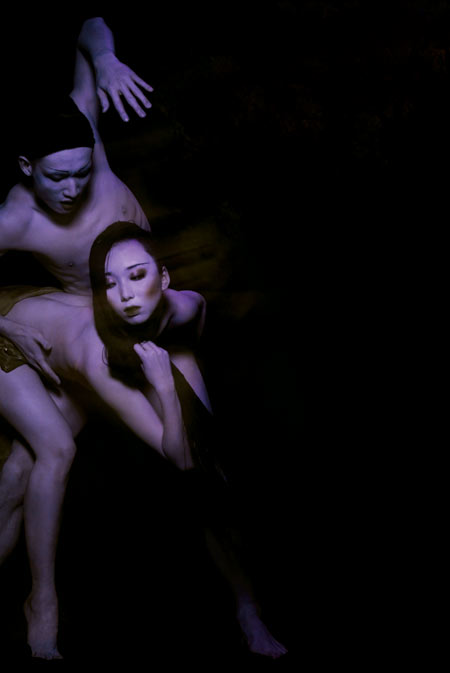The Golden Lotus: Fruity footwork

The Golden Lotus, or Jin Ping Mei, sometimes also known as The Plum in the Golden Vase, is believed to be the first full-length Chinese novel to depict explicit scenes of sexual intercourse. The Ming Dynasty (1368-1644) tale was long banned in China before its literary values were recognized. Today, though it has yet to enter into the official canon occupied by China's current Four Great Classical Novels, it is nevertheless accepted as a masterpiece of vernacular storytelling.
Tiptoeing around taboo
Now choreographer Wang Yuanyuan has employed expressive footwork and body language to turn this once-notorious story into a ballet, offering a female perspective on the tale of sexual politics in a powerful household within larger-than-life depiction of a corrupted society.
Commissioned for the 2011 Hong Kong Arts Festival, The Golden Lotus premiers on March 25, and ventures into taboo topics of money, sex and power while examining the various social figures from the point view of protagonist Pan Jinlian ("Jinlian" literally means "golden lotus").
Originally ascribed to the pseudonymous Lanling Xiaoxiao Sheng (The Scoffing Scholar of Lanling), the erotic epic follows the fortunes of Ximen Qing, a powerful local merchant during the Northern Song Dynasty (960-1157) whose household is a realm occupied by six wives and concubines.
Ximen is a corrupt and avaricious protagonist, as liable to betray locals as he is to bribe officials. His wives, Pan, Li Ping'er and Pang Chunmei come from diverse backgrounds, but share a dominating lust for love, sex and material goods. With their twisted personalities, they each try in vain to fight against each other, and a patriarchal, amoral society.
"When people talk about The Golden Lotus, they talk about sex accordingly. Although it is given considerable attention in the book, [it] is more than that," Wang, director of the Beijing Dance Theater, told the Global Times.
Scathing of society
The book reveals the landscape of a downward-heading society and deals with social issues such as the role of women in ancient China and attendant sexual politics.
Heavily made-up and scantly clad, the dancers cavort in intimate and sexual movements to show the lust and desire that saturates The Golden Lotus. But what Wang has in mind goes beyond that. "The reason I took on the tale is not to seek popularity or impress people, but to probe into social problems," said Wang, acclaimed choreographer of The Peony Pavilion and Raise the Red Lantern.
"I like to represent past stories with the mind-set of modern people. I believe life repeats itself. People, no matter what age they are living in, will experience the same thing. History is a repetition of reality," Wang explained.
Wang, founder of the first dance company in China to fuse ballet and modern dance, had the idea of turning the controversial book into a ballet three years ago; but the complicated relations among its 200 characters held her back.
How to condense the 100-chapter magnum opus into a 70-minute dance, while illustrating the complicated relations and social issues the book ponders on, and also displaying its sexual content in a more artistic way, were the biggest challenges for her. Having selected the most "typical" scenes from the book, Wang set up Pan as the central role and follows her marriage into the Ximen household. Through Pan's observation, Li, one of the wives, is an idealist who longs for everlasting love while Pang is a strong figure struggling for social independence.
"As a choreographer, what I want to do is to observe the whole of society and the various types of people. Power, money and lust can all be the reasons for their existence," said Wang. In the work, she added, there are prostitutes, brothel visitors and various small figures from the Ximen household. "No matter whether they are powerful or not, they all want money and power."
New Perspectives
Although Pan has long been considered by critics as a lustful woman whose sole desire is sexual pleasure and power in the family, Wang has tried hard not to attach any label to her in the ballet. Instead, she portrays through dance a simple woman who also has her own desires and needs.
Zhang Xiaochuan, who plays Pan, said she just dances the dance, without too many strings attached. "[Dancing] is like Pan's personality. She is simple in nature, as she just wants what she longs for. It is just like dancing: as long as you achieve what you are asked to do."
Featuring long pieces of duo and trois, Wang also created a ten-minute duo between the two leading female roles, Pan and Pang, in which Pan soothes Pang's disappointment following her marriage to Ximen.
"The duo shows Pang's three contrasting emotional changes, from being passive, to active then furious. For me, as a dancer, I like it as it is challenging to my dancing. Also, unlike a duo between a man and a woman, our dance has to be lighter, thus setting a higher standard for our performance," said Liang Xing, who dances Pan in another combination.
While looking forward to her Hong Kong premier, Wang is not sure if it will be able to be shown on the Chinese mainland.
However, with a production team which includes Oscar-winning designer Tim Yip and Chen Qigang, musical director of the Beijing Olympics' opening ceremony, Wang is confident her work will be appreciated by every audience.
 0
0 







Go to Forum >>0 Comments